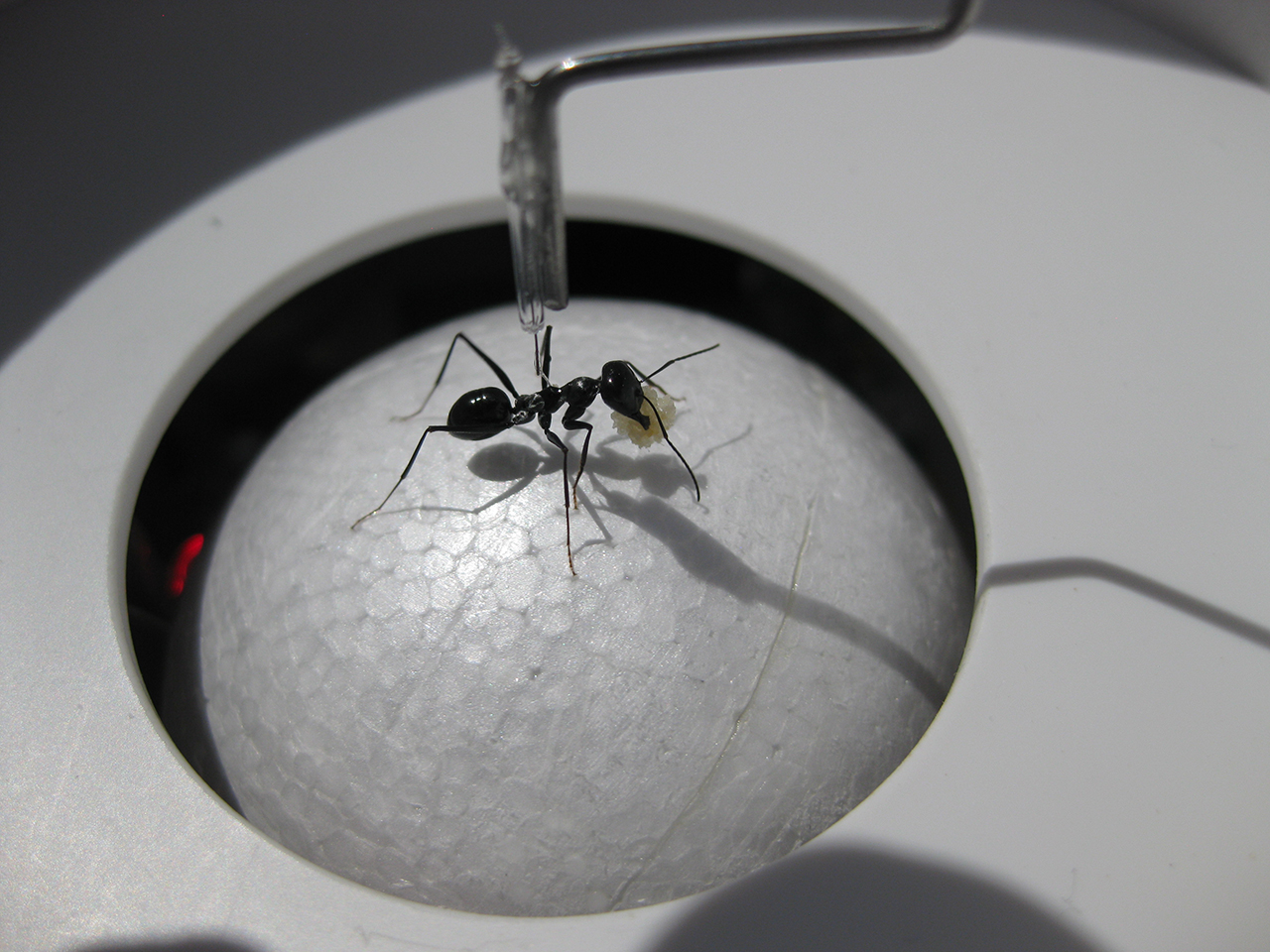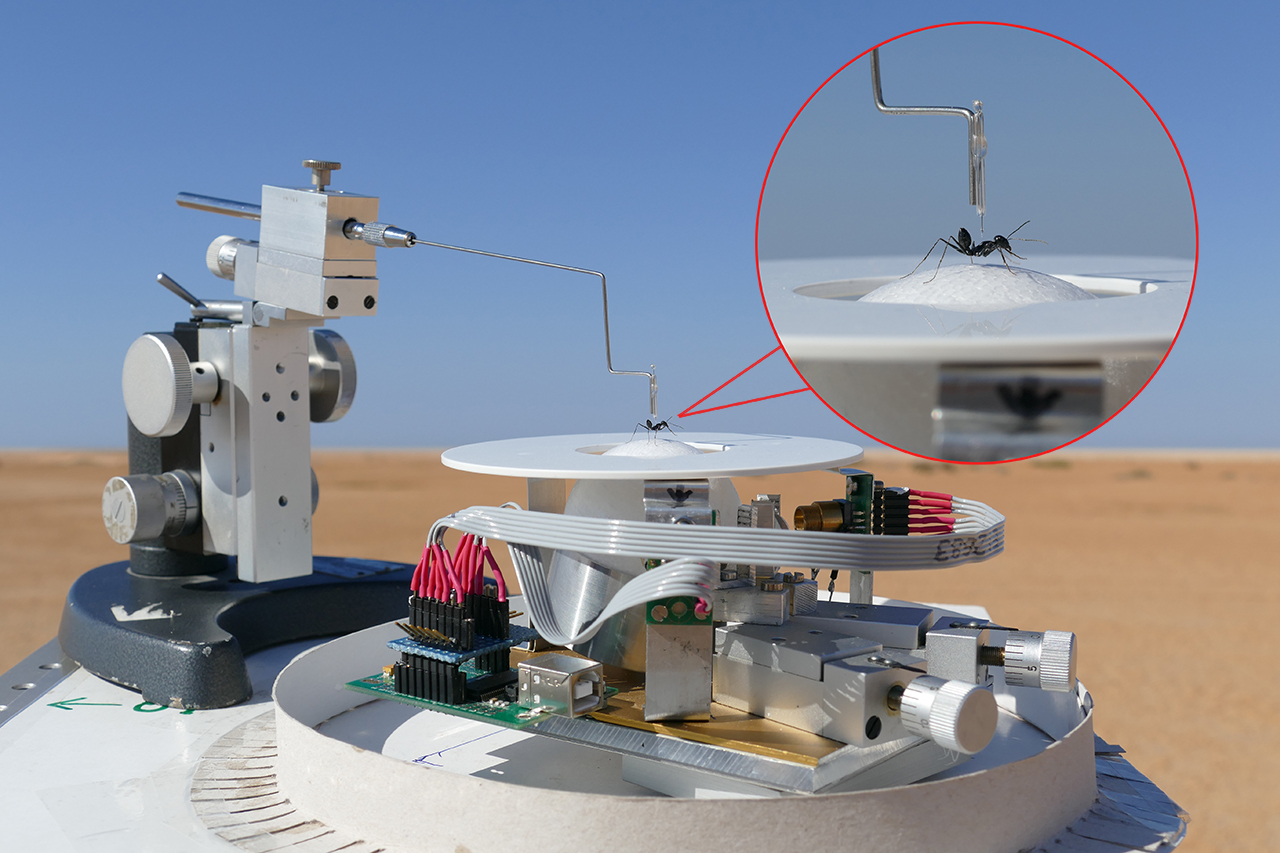Ants Scurry on 'Treadmills' for Science

Scientists study how animals walk and run by putting them on treadmills — from elephants and alligators to animals as tiny as an ant. Recently, researchers used a custom-made treadmill to study desert ants' fancy footwork, to better understand the mechanisms they use to navigate home.
This wasn't a scaled-down versions of the treadmill you'd find at a gym. Rather, the ants were tethered above a lightweight sphere. As the insects scampered forward — sometimes stopping and changing direction — the sphere would roll beneath them, and sensors recorded every step they took.
Using this equipment, researchers were able to reproduce ant homing behavior in a treadmill setting for the first time, analyzing the ants' movements in unprecedented detail to evaluate their walking speed and changes in gait as the insects searched for their nest. [Step Lively! Ants' Gaits Tracked on Treadmill | Video]
Spherical treadmills have been used in studies of small animals since the 1960s, but they have not been sensitive enough to follow the speedy motion of ants' tiny legs. For the new study, researchers built a treadmill made especially for ants. It incorporated a hollow, air-suspended Styrofoam ball that was highly responsive to the ants' movements, which the scientists tracked using optical mouse sensors.
"Our new design enables us to study the fast-running and very quickly turning desert ants," study co-author Matthias Wittlinger, a research fellow with the Institute of Neurobiology at Ulm University in Germany, told Live Science in an email.
The treadmill spins responsively as the ant walks; to keep the ant oriented but still able to move freely, tiny leashes made from a filament of dental floss were glued to the ants' back, then attached to pins that were suspended above the sphere. While this delicate attachment sounds tricky to perform, Wittlinger reported that it generally only took a few seconds to glue an ant to its tether.
Walk on the wild side
Ants were captured at a feeder located about 33 feet (10 meters) from their nest entrance, so they had already identified a route that would lead them back to the nest. Once they were placed on the treadmill, they trotted toward the nest's presumed location through mechanisms that prior studies had shown were critical to ant navigation: using the position of the sun and patterns of polarization in the sky as a compass, and calculating the distance by counting their own strides, Wittlinger said
Get the world’s most fascinating discoveries delivered straight to your inbox.
The treadmill allowed the scientists to record the direction and speed of the walking ants; the flexible tether enabled the animals to move with a more natural body posture than had been possible in past studies — "Old designs had the animal rigidly fixed," Wittlinger said.
"They virtually travel for many meters on the treadmill, as if they were running in the open field," he explained.
The study authors reported that the ants would begin their treadmill journeys with a direct approach — heading straight for the nest. But when the insects didn't find the nest where they expected it to be, they adopted a different locomotion pattern, which Wittlinger identified as "search mode."
The study's findings showed for the first time that when ants realize that they're lost, they switch to "search mode," slowing down and then moving in a looping pattern, Wittlinger told Live Science in an email.
By reproducing conditions that test this complex behavior in ants — navigating home — in an artificial setting, the scientists could control and adjust a variety of parameters, to better understand the mechanisms and neural signals related to navigation, Wittlinger explained.
The findings were published online Feb. 15 in the Journal of Experimental Biology.
Original article on Live Science.

Mindy Weisberger is a science journalist and author of "Rise of the Zombie Bugs: The Surprising Science of Parasitic Mind-Control" (Hopkins Press). She formerly edited for Scholastic and was a channel editor and senior writer for Live Science. She has reported on general science, covering climate change, paleontology, biology and space. Mindy studied film at Columbia University; prior to LS, she produced, wrote and directed media for the American Museum of Natural History in NYC. Her videos about dinosaurs, astrophysics, biodiversity and evolution appear in museums and science centers worldwide, earning awards such as the CINE Golden Eagle and the Communicator Award of Excellence. Her writing has also appeared in Scientific American, The Washington Post, How It Works Magazine and CNN.



